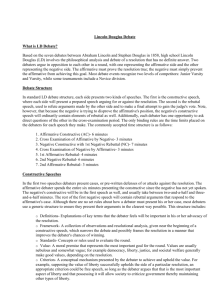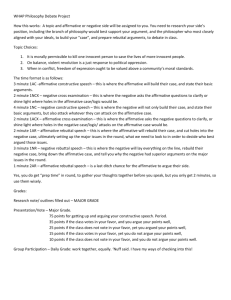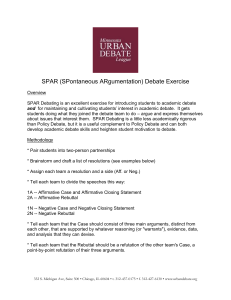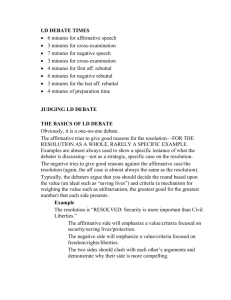Debate Terminology: Definitions & Preparation Guide
advertisement
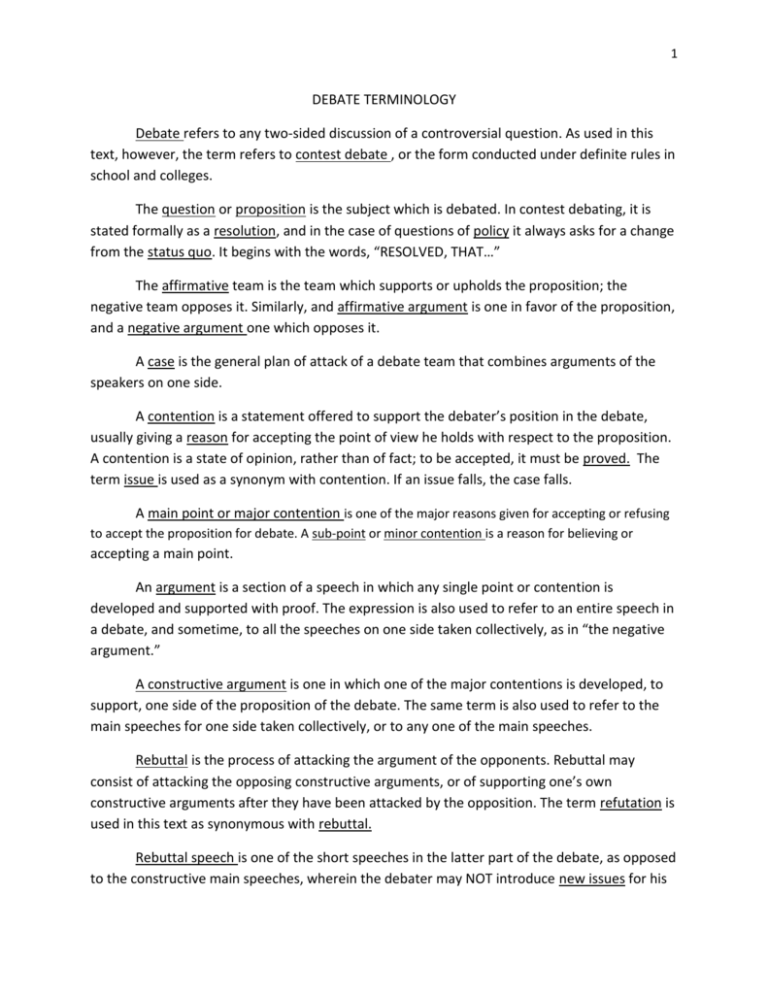
1 DEBATE TERMINOLOGY Debate refers to any two-sided discussion of a controversial question. As used in this text, however, the term refers to contest debate , or the form conducted under definite rules in school and colleges. The question or proposition is the subject which is debated. In contest debating, it is stated formally as a resolution, and in the case of questions of policy it always asks for a change from the status quo. It begins with the words, “RESOLVED, THAT…” The affirmative team is the team which supports or upholds the proposition; the negative team opposes it. Similarly, and affirmative argument is one in favor of the proposition, and a negative argument one which opposes it. A case is the general plan of attack of a debate team that combines arguments of the speakers on one side. A contention is a statement offered to support the debater’s position in the debate, usually giving a reason for accepting the point of view he holds with respect to the proposition. A contention is a state of opinion, rather than of fact; to be accepted, it must be proved. The term issue is used as a synonym with contention. If an issue falls, the case falls. A main point or major contention is one of the major reasons given for accepting or refusing to accept the proposition for debate. A sub-point or minor contention is a reason for believing or accepting a main point. An argument is a section of a speech in which any single point or contention is developed and supported with proof. The expression is also used to refer to an entire speech in a debate, and sometime, to all the speeches on one side taken collectively, as in “the negative argument.” A constructive argument is one in which one of the major contentions is developed, to support, one side of the proposition of the debate. The same term is also used to refer to the main speeches for one side taken collectively, or to any one of the main speeches. Rebuttal is the process of attacking the argument of the opponents. Rebuttal may consist of attacking the opposing constructive arguments, or of supporting one’s own constructive arguments after they have been attacked by the opposition. The term refutation is used in this text as synonymous with rebuttal. Rebuttal speech is one of the short speeches in the latter part of the debate, as opposed to the constructive main speeches, wherein the debater may NOT introduce new issues for his 2 side. However, he may use new evidence to support (or attack) the issues presented in the constructive speeches. A rebuttal point is a contention presented in the course of rebuttal or refutation-it may be presented either during the constructive speeches or in the rebuttal speeches. The rebuttal point is usually expressed as a statement directly denying or contradicting some point advanced by an opponent. Proof is the process of supporting a point with reasoning and evidence. Or, the term may refer to the materials-both reasoning and evidence which are used to support the statement. Reasoning is the process of giving reasons for believing a proposition of statement. Some process of reasoning is necessary to show the relationship between the statement to be proved and individual items of evidence which support it. Evidence is a term used to refer to various factual materials and opinions which are cited to support a contention or statement to be proved. The more important forms of evidence used in debate are instances, statistics, comparisons, illustrations, and statement of opinion by authorities. In this text, these various materials are also referred to as proof materials; the terms proof materials and evidence will be used as synonyms. In any debate, the affirmative always has the duty of fulfilling the burden of proof. Therefore, they have the privilege of opening and closing the debate. This means that they must present a case which is sufficiently strong: that is can stand while attacked. Unless they can do this, the negative must win the debate. Kinds of propositions: A. Fact- a proposition which seeks to find out the truth about a situation; for instance, Resolved, that the US economic aid has greatly helped under-developed countries. B. Value- a proposition which seeks to determine the worth of some idea or action; for example, Resolved, that the testing of atomic weapons is detrimental. C. Policy-a proposition which seeks to find out whether action should be taken regarding a certain situation; for example, Resolved, that the United States should adopt a system of national health insurance. In some debates, both sides are also given the chance to cross-examine, or question the other side about their statements. Various debate formats permit different arrangements of affirmative and negative speakers. 3 STEPS IN PREPARING FOR A DEBATE A. Analyze the proposition: It is the duty of all debaters to examine the question being debated in order to find out what it means. It is the privilege of the first speaker for the affirmative to define any terms in the proposition which may be in doubt, and this should be done in the opening minutes of his speech. It is the privilege of the first speaker for the negative to question that definition if he can show that it is in any way indefinite or unfair to him. If he does not do this, the debate must proceed according to the definition of terms presented by the affirmative. B. Choosing the main contentions (this outline is mainly concerned with a proposition of policy, since most high school and college debates are this type), 1. Questions the affirmative must be able to answer: a. Why do we NEED the plan to change from our present way? b. How will this PLAN (proposal) make things better? c. Will this proposal bring any other ADVANTAGES? If so, what are they? d. Why are my opponents wrong in attacking this proposal? 2. Questions the negative must be able to answer: a. Why is there no real NEED for such a plan (proposal)? b. Why will this new PLAN (proposal) bring no improvements? c. What new EVILS would result if we adopted such a plan? d. If it is obvious that something should be done, what other ideas are better than those of the affirmative? C. Choose the proof that must be used for each contention: 1. It is assumed that the debater will have done much research and taken notes on evidence before he begins to write his speech. It should be remembered that the most effective tool of good debating is adequate preparation. 2. Sources of proof: books, articles from databases, government records and other sources as seen on p. 1328 in Holt McDougal Grade 10 textbook. D. Taking notes-when using reference materials, be sure to note down the source of title, author, date, pages, and the information you are using, either word for word, or paraphrase. Keep a separate note card for each item. E. Prepare a working outline of your contentions-arrange your contentions, with the proof for each. Remember to summarize occasionally so the audience will not lose the point. F. Preparing a debate speech-it should contain an introduction, body and conclusion, like any other speech. It is especially important to secure the audience’s interest and outline your arguments for them, and to close by summarizing and giving them something to remember or do. 4 G. Prepare for rebuttal-even though the rebuttal is organized on the basis of the speeches presented and the proof given by your opponents, preparation can be made beforehand. The debater should try to find possible attacks which his opponents may make and prepare materials to meet these. In rebuttal, it is important to concentrate on the major arguments presented by the other team, and not waste time on minor points. Debate ethics and courtesy A debater is never justified in falsifying or “making up” evidence. This destroys the whole purpose of debate, to use facts to convince listeners. A debate is a formal presentation, and no competent debater ever loses his temper, or indulges in sarcasm or name-calling. He strives to maintain the idea that he and his opponents are intelligent, reasonable people trying to persuade listeners in the best possible manner. It is no more important to be a good winner than a good loser. 5 CONSTRUCTIVE SPEECHES AFFIRMATIVE I 1. Introduce and state proposition (may give brief history, importance of topic) 2. Define terms (if any) 3. Give brief overview of entire affirmative case 4. Develop aff. Case. State problem areaattribute to status quo. Present proof that SQ NEEDS to be changed. Outline PLAN 5. Summarize contentions (main points) indicating what has been shown and preview what affirmative II will show. AFFIRMATIVE II 1. Defend definitions if necessary. 2. Review affirmative Case briefly. 3. Construct remainder of aff. Case. Review plan. Present evidence that proves that the plan and its advantages will solve problems when associated with status quo. 4. Defend affirm arguments which have been attacked. 5. Attack negative constructive arguments. 6. Summarize. NEGATIVE 1 1. State negative stand in light of affirmative position. 2. Question definitions if necessary. 3. Construct bulk of negative case-SHOW CLASH 4. Refute affirmative case. Present proof chat CHANGE IS NOT NEEDED, PLAN WON’T WORK, or present disadvantages. 5. Summarize, illustrating what has been shown and preview what negative II will show. NEGATIVE II 1. State negative stand. 2. Complete construction of negative case (see #4 above). 3. Defend negative case in light of affirmative attack. 4. Attack affirmative’s plan and show disadvantages. 5. Summarize very briefly. Constructive Speeches1. Affirmative must prove: there is a NEED, PLAN is workable, and has ADVANTAGES. 2. Negative can choose many strategies but can win by disproving one of the above. 6 REBUTTALS NEGATIVE I 1. Continue attack on affirmative case by tearing down needs issue. 2. Rebuild negative constructive case (integrate 1 and 2) 3. Summarize in light of negative stand. NEGATIVE II CONSTRUCTIVE AND NEGATIVE I REBUTTAL SHOULD BE VIEWED AS A CONSECUTIVE PRESENTATION, NOT TWO SEPARATE SPEECHES. NEGATIVE II 1. Re-emphasize negative stand. 2. Show negative strength on each major issue; show how negative has challenged affirmative case successfully. 3. Summarize and press (question) affirmative for reply. AFFIRMATIVE I 1. Briefly outline what you plan to do. 2. Defend affirmative case at vital points. 3. Summarize very briefly. AFFIRMATIVE II 1. Re-substantiate entire affirmative case, stressing main issues at contention. 2. Emphasize weaknesses of negative case. 3. Summarize carefully and thoroughly. General Instructions1. Partners agree, in advance, which points each will defend (from main speech). 2. Reiterate first point you made, tell what the opposition has done to disprove, and then give more evidence to re-establish your point. 3. Do same for other main points. 4. Second speaker summarizes: statement of your belief in the soundness of your proposal. 5. Don’t offer your opinions. 7 DEBATE FORMAT Constructive Speeches 1st affirmative constructive speech 1st negative speaker cross examine 1st negative constructive speech 2nd affirmative speaker cross examine 2nd affirmative constructive speech 2nd negative speaker cross examine 2nd negative constructive speech 1st affirmative speaker cross examine 6 minutes 1 minute 6 minutes 1 minute 6 minutes 1 minute 6 minutes 1 minute Rebuttal Speeches 1st negative speaker 3 minutes 1st affirmative speaker 3 minutes 2nd negative speaker (closing) 3 minutes 2nd affirmative speaker (closing) 3 minutes Adapted from Speech: Exploring Communication. J. Regis O’Connor

